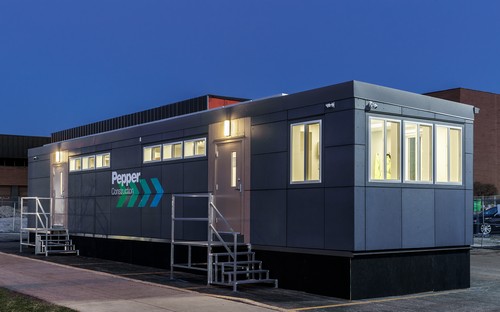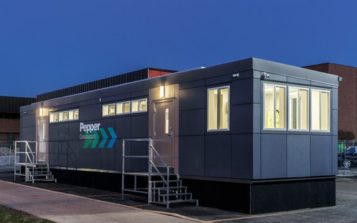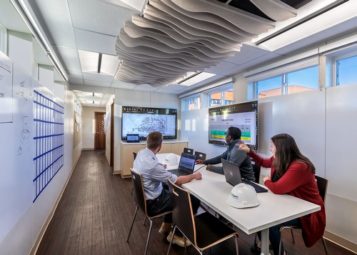
By Susan Heinking and Brandon Smrz
According to a recent report from integrated real estate services firm Stok, “The Financial Case for High Performance Buildings,” the business case for high-performance buildings traditionally cites energy savings and increased asset value as the most appealing incentives. But another — and arguably greater — form of enhanced value creation that comes through HPBs is rarely discussed: HPBs benefit the people who occupy them, which in turn produce significant positive impacts on a company’s bottom line1. If this is true for the buildings we construct, what about the jobsite trailers for construction superintendents and workers?
The impetus
In 2009, Chicago, Illinois’ Clean Diesel Construction ordinance introduced new requirements focused on improving air quality on and near city of Chicago construction sites. The ordinance offers an opportunity for our industry to think differently about how we can reduce emissions in the atmosphere and on our jobsites at the same time. For example, it is possible that trailers could run on clean energy rather than depend on diesel generators. More broadly, if the AEC industry is striving to build greener buildings, and owners and developers are asking for sustainable buildings, how could we apply those strategies on construction jobsites?
Jobsites
Construction is a demanding job. The jobsite trailer has the potential to be a place of respite for our teams onsite. By thoroughly examining a jobsite, and making improvements, Pepper Construction saw opportunities to help promote better employee health and well-being, increase worker productivity and create a sense of community.
As you know, the number of trucks making deliveries can’t be controlled. However, we are able to insist that when they’re on the jobsite, drivers turn off their engines instead of idling and releasing emissions. This is one small, albeit important step. But we wanted to take this further and looked at the jobsite trailer — realizing we can push the envelope on this and implement the same HPB standards in this as we do in our clients’ buildings.
Net Zero Trailer
Most people spend about 90 percent of their time indoors, and that environment has a significant impact on their health. That also applies to the men and women working on jobsites. When Pepper looked at creating an environment that promotes healthier employees, we realized that traditional jobsite trailers didn’t match our commitment to the environment or our staff. This is where we started in 2017 – with the purpose of redesigning a jobsite trailer to focus on the human experience, productivity and quality from every aspect. We wanted our trailer to match our values – from air quality to basic human comforts and energy consumption.
We polled our superintendents and field team to determine important features that should be included in the new trailer to implement meaningful changes and improvements to their health. For example, it was suggested we include ergonomic stand-up desks, a break room, indoor restroom, a kitchen and natural daylight. Added to this list were additional elements that will encourage the crews to use fewer resources, such as writeable walls and desks, and no shelves for binders so that the jobsite is completely paperless.
The nuts and bolts
Inside the trailer is a gathering room that hosts up to 14 people and hoteling space for visitors. Furnished with Red List-Free furniture and materials, the modern design is flexible and collaborative. Daylight streams into the space, eliminating the need for candescent lighting. Reclaimed wood cabinets illustrate the team’s solid understanding of where materials are sourced from, while bamboo flooring is a durable alternative to the typical vinyl flooring options. Thoughtful details such as locker storage and flexible work space, complete with folding meeting space furniture, transform previously utilitarian conditions into a modern, functional and healthy work space.
Essentially a tiny building, Pepper’s Net Zero Trailer works holistically as one system to reduce the demand for energy. The average jobsite construction trailer emits 53,712 pounds of CO2 emissions into the air each year through its energy use. That means that each year, a jobsite’s carbon footprint equates to the energy of four residential homes. Pepper’s Net Zero trailer uses 100 percent less energy than a traditional trailer through thoughtful design.
The trailer is clad in cement fiber panels, which reduce heat absorption. To further increase energy efficiency and eliminate temperature swings, the envelope features a thermal barrier from 6 inches of rigid insulation, doubling the R-values for the walls, floor and roof, which now range from R-30 to R-40. Atop the structure, 27 photovoltaic panels convert just four hours of sunlight into the needed electricity to power the trailer for a full work day.
Results
Simply put, this trailer has improved jobsite morale and the comfort of our team. When superintendents and tradespeople enter the trailer, knowing that it was designed to improve their work day and that the company places value in their importance on the project, they work harder and feel appreciated. It’s a tangible way to communicate that they are important to our company.
The Net Zero Trailer is in use at a jobsite in Buffalo Grove, Illinois. Superintendents throughout Pepper regularly ask when it will be available on other jobsites – clearly, it is well received. We saw a similar response to the trailer when it debuted at this year’s Greenbuild. Our hope is that the Net Zero Trailer will inspire our industry to think differently so that the jobsites of the not-too-distant future can more positively impact worker performance and productivity, retention and health and well-being.
To read more about the Net Zero Trailer, visit: https://www.pepperconstruction.com/blog/pepper-construction-unveils-net-zero-construction-jobsite-trailer
Susan Heinkin, AIA, GACP, is vice president of High Performance and Sustainable Construction and a LEED Fellow with Pepper Construction Group. She can be reached at SHeinking@pepperconstruction.com.
Brandon Smrz, GACP, is assistant superintendent with Pepper Construction Group and can be reached at BSmrz@pepperconstruction.com.
1https://stok.com/research/financial-case-for-high-performance-buildings-1?utm_expid=.qN1m_0VwTwKtrx8HywIrxg.1&utm_referrer=https%3A%2F%2Fwww.clarkconstruction.com%2Fnews%2F5-key-takeaways-clark%25E2%2580%2599s-industry-event-making-case-green-and-healthy-buildings (accessed Dec. 14, 2018).





 Join our thriving community of 70,000+ superintendents and trade professionals on LinkedIn!
Join our thriving community of 70,000+ superintendents and trade professionals on LinkedIn! Search our job board for your next opportunity, or post an opening within your company.
Search our job board for your next opportunity, or post an opening within your company. Subscribe to our monthly
Construction Superintendent eNewsletter and stay current.
Subscribe to our monthly
Construction Superintendent eNewsletter and stay current.